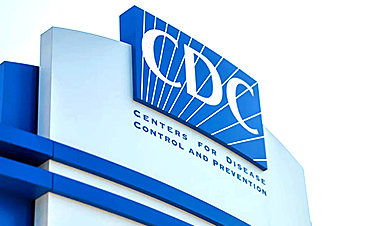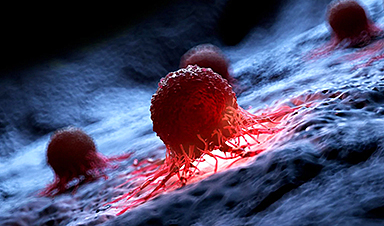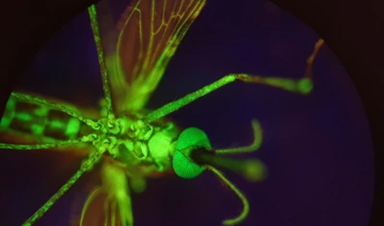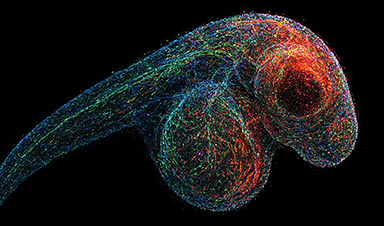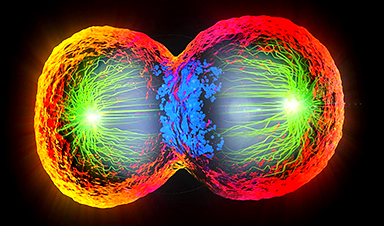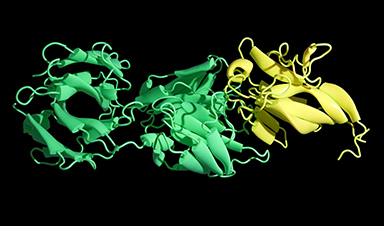Lawrence Livermore National Laboratory (LLNL) scientists have developed a new method for 3D printing living microbes in controlled patterns, expanding the potential for using engineered bacteria to recover rare-earth metals, clean wastewater, detect uranium, and more.
Through a novel technique that uses light and bacteria-infused resin to produce 3D-patterned microbes, the research team successfully printed artificial biofilms resembling the thin layers of microbial communities prevalent in the real world. The research team suspended the bacteria in photosensitive bioresins and “trapped” the microbes in 3D structures using LED light from the LLNL-developed Stereolithographic Apparatus for Microbial Bioprinting (SLAM) 3D printer. The projection stereolithography machine can print at high resolution on the order of 18 microns — nearly as thin as the diameter of a human cell.
In the paper, which appears online in the journal Nano Letters, researchers proved the technology can be used effectively to design structurally defined microbial communities. They demonstrated the applicability of such 3D-printed biofilms for uranium biosensing and rare-earth biomining applications and showed how geometry influences the performance of the printed materials.
“We are trying to push the edge of 3D microbial culturing technology,” said principal investigator and LLNL bioengineer William “Rick” Hynes. “We think it’s a very under-investigated space and its importance is not well understood yet. We’re working to develop tools and techniques that researchers can use to better investigate how microbes behave in geometrically complex, yet highly controlled conditions. By accessing and enhancing applied approaches with greater control over the 3D structure of the microbial populations, we will be able to directly influence how they interact with each other and improve system performance within a biomanufacturing production process.”
While seemingly simple, Hynes explained that microbial behaviors are actually extremely complex, and are driven by spatiotemporal characteristics of their environment, including the geometric organization of microbial community members. How microbes are organized can affect a range of behaviors, such as how and when they grow, what they eat, how they cooperate, how they defend themselves from competitors and what molecules they produce, Hynes said.
Previous methods for producing biofilms in the laboratory have provided scientists with little control over microbial organization within the film, limiting the ability to fully understand the complex interactions seen in bacterial communities in the natural world, Hynes explained. The ability to bioprint microbes in 3D will allow LLNL scientists to better observe how bacteria function in their natural habitat, and investigate technologies such as microbial electrosynthesis, in which “electron-eating” bacteria (electrotrophs) convert surplus electricity during off-peak hours to produce biofuels and biochemicals.
Currently, microbial electrosynthesis is limited because interfacing between electrodes (usually wires or 2D surfaces) and bacteria is inefficient, Hynes added. By 3D printing microbes in devices combined with conductive materials, engineers should achieve a highly conductive biomaterial with a greatly expanded and enhanced electrode-microbe interface, resulting in much more efficient electrosynthesis systems.
Biofilms are of increasing interest to industry, where they are used to remediate hydrocarbons, recover critical metals, remove barnacles from ships and as biosensors for a variety of natural and man-made chemicals. Building on synthetic biology capabilities at LLNL, where bacterium Caulobacter crescentus was genetically modified to extract rare-earth metals and detect uranium deposits, LLNL researchers explored the effect of bioprinting geometry on microbial function in the latest paper.
In one set of experiments, researchers compared the recovery of rare-earth metals in different bioprinted patterns and showed that cells printed in a 3D grid can absorb the metal ions much more rapidly than in conventional bulk hydrogels. The team also printed living uranium sensors, observing increased fluorescence in the engineered bacteria when compared to control prints.
“The development of these effective biomaterials with enhanced microbial functions and mass transport properties has important implications for many bio-applications,” said co-author and LLNL microbiologist Yongqin Jiao. “The novel bioprinting platform not only improves system performance and scalability with optimized geometry, but maintains cell viability and enables long-term storage.”
LLNL researchers are continuing to work on developing more complex 3D lattices and creating new bioresins with better printing and biological performance. They are evaluating conductive materials such as carbon nanotubes and hydrogels to transport electrons and feed-bioprinted electrotrophic bacteria to enhance production efficiency in microbial electrosynthesis applications. The team also is determining how to best optimize bioprinted electrode geometry for maximizing mass transport of nutrients and products through the system.
“We are only just beginning to understand how structure governs microbial behavior and this technology is a step in that direction,” said LLNL bioengineer and co-author Monica Moya. “Manipulating both the microbes and their physiochemical environment to enable more sophisticated function has a range of applications that include biomanufacturing, remediation, biosensing/detection and even development of engineered living materials — materials that are autonomously patterned and can self-repair or sense/respond to their environment.”
News
New Blood Test Detects Alzheimer’s and Tracks Its Progression With 92% Accuracy
The new test could help identify which patients are most likely to benefit from new Alzheimer’s drugs. A newly developed blood test for Alzheimer’s disease not only helps confirm the presence of the condition but also [...]
The CDC buried a measles forecast that stressed the need for vaccinations
This story was originally published on ProPublica, a nonprofit newsroom that investigates abuses of power. Sign up to receive our biggest stories as soon as they’re published. ProPublica — Leaders at the Centers for Disease Control and Prevention [...]
Light-Driven Plasmonic Microrobots for Nanoparticle Manipulation
A recent study published in Nature Communications presents a new microrobotic platform designed to improve the precision and versatility of nanoparticle manipulation using light. Led by Jin Qin and colleagues, the research addresses limitations in traditional [...]
Cancer’s “Master Switch” Blocked for Good in Landmark Study
Researchers discovered peptides that permanently block a key cancer protein once thought untreatable, using a new screening method to test their effectiveness inside cells. For the first time, scientists have identified promising drug candidates [...]
AI self-cloning claims: A new frontier or a looming threat?
Chinese scientists claim that some AI models can replicate themselves and protect against shutdown. Has artificial intelligence crossed the so-called red line? Chinese researchers have published two reports on arXiv claiming that some artificial [...]
New Drug Turns Human Blood Into Mosquito-Killing Weapon
Nitisinone, a drug for rare diseases, kills mosquitoes when present in human blood and may become a new tool to fight malaria, offering longer-lasting, environmentally safer effects than ivermectin. Controlling mosquito populations is a [...]
DNA Microscopy Creates 3D Maps of Life From the Inside Out
What if you could take a picture of every gene inside a living organism—not with light, but with DNA itself? Scientists at the University of Chicago have pioneered a revolutionary imaging technique called volumetric DNA microscopy. It builds [...]
Scientists Just Captured the Stunning Process That Shapes Chromosomes
Scientists at EMBL have captured how human chromosomes fold into their signature rod shape during cell division, using a groundbreaking method called LoopTrace. By observing overlapping DNA loops forming in high resolution, they revealed that large [...]
Bird Flu Virus Is Mutating Fast – Scientists Say Our Vaccines May Not Be Enough
H5N1 influenza is evolving rapidly, weakening the effectiveness of existing antibodies and increasing its potential threat to humans. Scientists at UNC Charlotte and MIT used high-performance computational modeling to analyze thousands of viral protein-antibody interactions, revealing [...]
Revolutionary Cancer Vaccine Targets All Solid Tumors
The method triggers immune responses that inhibit melanoma, triple-negative breast cancer, lung carcinoma, and ovarian cancer. Cancer treatment vaccines have been in development since 2010, when the first was approved for prostate cancer, followed [...]
Scientists Uncover Hidden Protein Driving Autoimmune Attacks
Scientists have uncovered a critical piece of the puzzle in autoimmune diseases: a protein that helps release immune response molecules. By studying an ultra-rare condition, researchers identified ArfGAP2 as a key player in immune [...]
Mediterranean neutrino observatory sets new limits on quantum gravity
Quantum gravity is the missing link between general relativity and quantum mechanics, the yet-to-be-discovered key to a unified theory capable of explaining both the infinitely large and the infinitely small. The solution to this [...]
Challenging Previous Beliefs: Japanese Scientists Discover Hidden Protector of Heart
A Japanese research team found that the oxidized form of glutathione (GSSG) may protect heart tissue by modifying a key protein, potentially offering a novel therapeutic approach for ischemic heart failure. A new study [...]
Millions May Have Long COVID – So Why Can’t They Get Diagnosed?
Millions of people in England may be living with Long Covid without even realizing it. A large-scale analysis found that nearly 10% suspect they might have the condition but remain uncertain, often due to [...]
Researchers Reveal What Happens to Your Brain When You Don’t Get Enough Sleep
What if poor sleep was doing more than just making you tired? Researchers have discovered that disrupted sleep in older adults interferes with the brain’s ability to clean out waste, leading to memory problems [...]
How to prevent chronic inflammation from zombie-like cells that accumulate with age
In humans and other multicellular organisms, cells multiply. This defining feature allows embryos to grow into adulthood, and enables the healing of the many bumps, bruises and scrapes along the way. Certain factors can [...]


